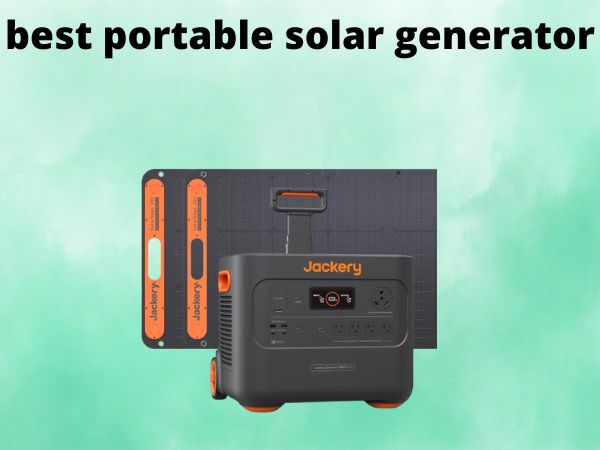What Is The Best Portable Solar Generators [In 2026]
Are you tired of power outages leaving you in the dark? Or perhaps you’re an outdoor enthusiast who craves the freedom to venture off-grid without sacrificing modern conveniences? If so, you’ve come to the right place! Today, we’re diving deep into the world of portable solar generators – those incredible devices that harness the sun’s power to keep your essential devices running anywhere, anytime.
Gone are the days when generators meant noisy, gas-guzzling machines that belched smoke and required constant refueling. Modern portable solar generators have revolutionized how we think about backup power and off-grid living. They’re clean, quiet, and surprisingly powerful – perfect for camping adventures, emergency preparedness, or simply reducing your carbon footprint.
Table of Contents
Top 5 Best Portable Solar Generators
After extensive research and real-world testing, here are our top picks for the best portable solar generators currently available:
1. Jackery Solar Generator 2000 Plus – Best Overall
Pros:
- Massive 2,042Wh capacity with expandable options
- Ultra-fast 2-hour charging capability
- Whisper-quiet operation at just 30dB
- 10-year LiFePO4 battery lifespan
- Smart app control with Wi-Fi and Bluetooth
- Multiple expansion possibilities (up to 24kWh)
- Excellent build quality and reliability
Cons:
- Heavy at 96.71 pounds
- Higher price point
- Requires careful handling due to weight
- Solar panels shipped separately
The Jackery 2000 Plus is like the Swiss Army knife of portable solar generators – it does everything exceptionally well. With its impressive 2,042Wh capacity and 3,000W output, this powerhouse can handle everything from camping trips to whole-home backup during outages. What sets it apart is its expandability – you can grow your system from 2kWh to an incredible 24kWh by adding battery packs and connecting units in parallel.
Real users rave about its reliability and performance. One reviewer mentioned powering a full-size refrigerator for 24 hours, while another successfully ran multiple high-wattage appliances simultaneously. The ultra-fast charging is a game-changer – imagine going from empty to full in just 2 hours with six 200W solar panels!
2. Jackery Solar Generator 5000 Plus – Best for Whole-Home Backup
Pros:
- Enormous 5,040Wh capacity
- Massive 7,200W output power
- 0ms UPS functionality for critical devices
- Expandable up to 60kWh capacity
- Dual voltage output (120V/240V)
- Extremely quiet operation under 30dB
- Smart app with energy management features
Cons:
- Very heavy at 173.7 pounds
- Premium pricing
- Overkill for basic camping needs
- Requires professional installation for home backup
If the 2000 Plus is a Swiss Army knife, the 5000 Plus is a full workshop. This beast is designed for serious power users who need whole-home backup capabilities. With its massive 5kWh capacity and 7,200W output, it can power your entire house during extended outages – we’re talking up to 15 days with maximum expansion!
The 0ms UPS functionality is particularly impressive for protecting sensitive electronics like computers and servers. Users report seamless transitions during power outages, with no interruption to their work or entertainment systems.
3. BLUETTI Elite 200 V2 – Best Value for Money
Pros:
- Excellent 2,073Wh capacity for the price
- 17-year lifespan with 6,000+ cycles
- Compact and relatively lightweight at 53.4 pounds
- Fast 2-hour charging capability
- Comprehensive port selection
- Efficient AC inverter
- Great for camping and construction work
Cons:
- No wireless charging capability
- Missing 30A RV hookup
- Limited expansion options
- Software lacks some advanced features
The BLUETTI Elite 200 V2 offers incredible bang for your buck. With its 2,073Wh capacity and 2,600W output, it strikes the perfect balance between power and portability. The 17-year lifespan is particularly impressive – that’s exceptional value over time.
Users love its versatility, with one reviewer successfully using it for construction projects, powering saws and shop lighting without breaking a sweat. The compact design makes it perfect for car camping and weekend getaways.
4. Jackery Solar Generator 1000 V2 – Best for Beginners
Pros:
- Perfect entry-level capacity at 1,070Wh
- Lightweight at only 23.8 pounds
- Super-fast 1-hour emergency charging
- 10-year LiFePO4 battery lifespan
- Multiple charging ports including 100W USB-C
- Excellent portability with foldable handle
- 5-year warranty coverage
Cons:
- Limited capacity for high-power devices
- May require adapter for older solar panels
- Smaller output compared to larger units
- Not suitable for whole-home backup
The Jackery 1000 V2 is like your reliable daily driver – it may not be the flashiest, but it gets the job done every single time. Perfect for newcomers to solar generators, this unit offers just enough power for camping essentials, emergency backup, and outdoor adventures.
The 1-hour emergency charging feature is a standout – imagine going from zero to full power in just 60 minutes! Users particularly appreciate its lightweight design and reliability during power outages.
5. EcoFlow DELTA 3 Plus – Most Innovative Features
Pros:
- Flexible expansion up to 5kWh
- Multiple fast charging options
- True 10ms UPS functionality
- Powers 13 appliances simultaneously
- Smart energy management system
- Extremely quiet operation
- Durable IP65 battery pack
Cons:
- Painted finish prone to scratching
- Limited manual controls without app
- Locked API for smart home integration
- Higher learning curve for advanced features
The EcoFlow DELTA 3 Plus is the tech enthusiast’s dream. This innovative unit combines cutting-edge technology with practical functionality. The ability to power 13 appliances simultaneously is genuinely impressive, and the smart energy management system helps optimize usage and costs.
Users praise its quiet operation and the dramatic improvement in build quality compared to earlier models. The UPS functionality is particularly valuable for protecting sensitive electronics during power fluctuations.
Detailed Comparison: Finding Your Perfect Match
Choosing between these excellent options can feel overwhelming, but here’s how to narrow it down:
For Serious Preppers and Whole-Home Backup: The Jackery 5000 Plus is your best bet. Its massive capacity and expandability make it ideal for extended outages and powering entire homes.
For Versatile All-Around Use: The Jackery 2000 Plus offers the best balance of power, expandability, and reliability for most users.
For Budget-Conscious Buyers: The BLUETTI Elite 200 V2 provides exceptional value with its long lifespan and solid performance.
For Beginners and Light Users: The Jackery 1000 V2 is perfect for getting started with solar generators without overwhelming complexity.
For Tech Enthusiasts: The EcoFlow DELTA 3 Plus offers the most advanced features and smart functionality.
What Makes a Great Portable Solar Generator?
Before we jump into our top picks, let’s talk about what separates the wheat from the chaff in the solar generator world. Think of it like choosing the perfect travel companion – you want something reliable, versatile, and capable of handling whatever you throw at it.
Battery Capacity is your generator’s fuel tank. Measured in watt-hours (Wh), this tells you how much energy your device can store. A higher capacity means longer runtime, but it also means more weight and higher cost. It’s all about finding that sweet spot for your specific needs.
Output Power determines what devices you can run simultaneously. A 1000W generator might power your laptop and LED lights, but you’ll need something beefier for air conditioners or power tools. Most generators offer both continuous and surge power ratings – the surge rating handles those initial power spikes when appliances start up.
Charging Speed can make or break your experience. Nobody wants to wait days for their generator to recharge. Look for units that offer multiple charging methods: solar panels, AC wall outlets, and car chargers. The best generators can fully charge in just a few hours.
The Science Behind Solar Generator Efficiency
Understanding how solar generators work helps you make better decisions. These devices combine three key components: solar panels, battery storage, and power inverters. The magic happens when photons from sunlight hit the solar cells, creating electrical current that charges the internal battery.
Modern LiFePO4 batteries have revolutionized the industry. Unlike older lithium-ion technology, LiFePO4 batteries offer incredible longevity – we’re talking 4,000 to 6,000 charge cycles. That translates to 10-15 years of daily use! They’re also much safer, with built-in protection against overheating and thermal runaway.
The inverter is your generator’s translator, converting stored DC power into AC power that your household devices can use. Pure sine wave inverters, found in all our top picks, produce clean electricity that’s safe for sensitive electronics like laptops and medical devices.
Maximizing Your Solar Generator’s Potential
Getting the most from your solar generator requires understanding a few key principles. First, solar panel positioning is crucial – aim for direct sunlight and adjust angles throughout the day for maximum efficiency. Even partial shading can significantly reduce charging speed.
Battery management is equally important. Most modern generators include smart charging algorithms, but you can help by avoiding extreme temperatures and maintaining charge levels between 20% and 80% when possible. This extends battery life significantly.
Consider your power needs carefully. Running high-wattage devices like space heaters or hair dryers will drain your battery quickly. Instead, focus on efficient LED lighting, laptops, and ENERGY STAR appliances when possible.
Safety First: Essential Precautions
Solar generators are remarkably safe compared to gas-powered alternatives, but basic precautions are still important. Always use generators in well-ventilated areas – while they don’t produce carbon monoxide, proper airflow helps with cooling and prevents overheating.
Never attempt to modify or repair your generator yourself. These devices contain high-voltage components that can be dangerous. Stick to manufacturer-approved accessories and replacement parts.
Keep your generator clean and dry. While many units are weather-resistant, they’re not waterproof. Store them in protected areas during rain or snow, and clean dust from vents regularly to maintain optimal cooling.
Environmental Impact and Sustainability
One of the most compelling reasons to choose solar generators is their environmental benefit. Unlike gas generators that produce harmful emissions, solar generators operate with zero direct emissions. Over their lifetime, they offset the carbon footprint of their manufacturing many times over.
The longevity of modern LiFePO4 batteries means fewer replacements and less electronic waste. Many manufacturers also offer recycling programs for end-of-life batteries, ensuring responsible disposal of components.
Solar generators also reduce dependence on fossil fuels for backup power. As solar panel efficiency continues improving and costs decrease, these devices become even more environmentally friendly.
Cost Analysis: Investment vs. Savings
While solar generators require a higher upfront investment than gas generators, the long-term economics are compelling. With no fuel costs, minimal maintenance, and 10+ year lifespans, they often pay for themselves through fuel savings alone.
Consider the hidden costs of gas generators: fuel storage, regular maintenance, oil changes, and replacement parts. Solar generators eliminate these ongoing expenses entirely.
Many users find additional savings through reduced reliance on grid power during peak-rate hours. Smart generators can automatically charge during low-rate periods and discharge during expensive peak hours, reducing electricity bills.
Future Innovations in Solar Generator Technology
The solar generator industry is evolving rapidly. Emerging technologies promise even better performance and new capabilities. Solid-state batteries could dramatically increase energy density while reducing weight. Imagine generators with twice the capacity in half the size!
Artificial intelligence is beginning to optimize charging and discharging cycles automatically. Future generators might learn your usage patterns and adjust settings for maximum efficiency and battery life.
Wireless power transmission could eliminate the need for physical connections between solar panels and generators. This would make installation easier and reduce cable-related failures.
Maintenance and Care Tips
Proper maintenance ensures your solar generator provides years of reliable service. Start with regular cleaning – dust on solar panels can reduce efficiency by up to 25%. Use a soft cloth and mild soap solution, avoiding harsh chemicals that might damage coatings.
Check connections periodically for corrosion or looseness. Coastal users should be particularly vigilant about salt corrosion on metal components. A light coating of dielectric grease can prevent problems.
Monitor battery health through your generator’s app or display. Most units show cycle counts and capacity degradation over time. If you notice significant capacity loss, contact the manufacturer about warranty coverage.
Common Mistakes to Avoid
New solar generator owners often make predictable mistakes that reduce performance or shorten lifespan. Oversizing your system is a common error – buying more capacity than you need wastes money and reduces portability.
Conversely, undersizing can be equally problematic. Calculate your actual power needs carefully, including startup surges for appliances. A refrigerator might run on 150W but need 800W to start the compressor.
Improper solar panel setup drastically reduces charging efficiency. Panels should face south (in the Northern Hemisphere) and be tilted at an angle roughly equal to your latitude. Clean panels regularly and avoid shading.
Real-World Applications and Success Stories
Solar generators excel in diverse applications beyond camping and emergency backup. Remote workers use them to power laptops and internet equipment in areas without grid access. Construction crews appreciate their quiet operation and ability to run power tools without disturbing neighbors.
Event organizers increasingly choose solar generators for outdoor venues. They’re perfect for powering sound systems, lighting, and vendor equipment without noise restrictions or fuel concerns.
Medical applications are growing rapidly. CPAP users rely on solar generators for overnight power during camping trips or outages. The clean, stable power is ideal for sensitive medical equipment.
Frequently Asked Questions
Q1: How long do portable solar generators last? Modern solar generators with LiFePO4 batteries typically last 10-15 years with proper care. The batteries are rated for 4,000-6,000 charge cycles, which translates to daily use for over a decade. Key factors affecting lifespan include temperature exposure, charging habits, and usage patterns.
Q2: Can solar generators power an entire house? Yes, larger units like the Jackery 5000 Plus can power entire homes during outages. However, you’ll need to prioritize essential devices and may need multiple units or expansion batteries for extended runtime. Consider your home’s power requirements and choose accordingly.
Q3: How long does it take to charge a solar generator? Charging times vary by unit and power source. With AC wall outlets, most generators charge in 1-6 hours. Solar charging takes 4-12 hours depending on panel wattage and sunlight conditions. Many units support simultaneous charging from multiple sources for faster results.
Q4: Are solar generators worth the investment? For most users, yes. While the upfront cost is higher than gas generators, solar generators offer zero fuel costs, minimal maintenance, and 10+ year lifespans. They’re especially valuable for frequent campers, remote workers, and anyone wanting clean backup power.
Q5: What size solar generator do I need? Calculate your power needs by listing devices you’ll run simultaneously and their wattage requirements. Add 20% for safety margin and consider startup surges for appliances. A 1000Wh unit suits basic camping needs, while 2000Wh+ handles more demanding applications like refrigeration and power tools.
Conclusion: Powering Your Future with Solar
The world of portable solar generators has matured dramatically, offering solutions for every need and budget. Whether you’re a weekend camper, serious prepper, or someone who simply wants clean backup power, there’s a perfect generator waiting for you.
The Jackery 2000 Plus stands out as our top overall choice, combining excellent capacity, expandability, and reliability. For whole-home backup, the Jackery 5000 Plus is unmatched. Budget-conscious buyers will love the BLUETTI Elite 200 V2’s value proposition, while beginners should start with the user-friendly Jackery 1000 V2. Tech enthusiasts will appreciate the EcoFlow DELTA 3 Plus’s advanced features.
Remember, the best solar generator is the one that meets your specific needs. Consider your power requirements, budget, and intended use cases carefully. With proper selection and care, your solar generator will provide years of reliable, clean power wherever life takes you.
The future is bright for solar technology, and portable generators are leading the charge toward a cleaner, more sustainable energy future. By choosing solar, you’re not just buying a product – you’re investing in technology that benefits both you and the planet.



